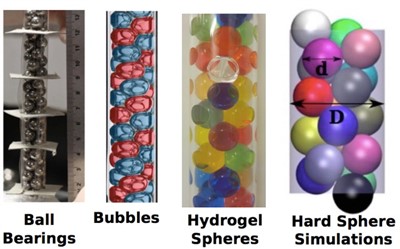Soft Matter Laboratory
The Soft Matter Laboratory is an interdisciplinary facility, spanning experimental research from both the Mathematics and Physics departments, particularly in the areas of Foams, Soft Photonics, and Topology & Geometry in Condensed Matter.

 Aqueous foams are a familiar “bubbly” mixture of air and liquid with, surprisingly, the properties of an elasto-plastic solid. Our experimental facilities include a bespoke rig for studying rheological flows of two-dimensional foams as well as equipment for examining three-dimensional foam structure and stability.
Aqueous foams are a familiar “bubbly” mixture of air and liquid with, surprisingly, the properties of an elasto-plastic solid. Our experimental facilities include a bespoke rig for studying rheological flows of two-dimensional foams as well as equipment for examining three-dimensional foam structure and stability. Despite the availability of elaborate varieties of nanoparticles, their assembly into periodic superstructures and photonic materials remains challenging. Our work into the novel use of soft (e.g. polymer) nanomaterials in the design of photonic structures, with shear-induced bulk ordering in viscoelastic media, has opened generic routes towards manufacturable optical materials. See- Polymer International (2013) 62, pp.1403–1407, Nature Communications (2016) 7, 11661.
Despite the availability of elaborate varieties of nanoparticles, their assembly into periodic superstructures and photonic materials remains challenging. Our work into the novel use of soft (e.g. polymer) nanomaterials in the design of photonic structures, with shear-induced bulk ordering in viscoelastic media, has opened generic routes towards manufacturable optical materials. See- Polymer International (2013) 62, pp.1403–1407, Nature Communications (2016) 7, 11661. Our work is focused on the behaviour of soft matter in confined spaces. On the one hand we are interested in the self-assembly and packing of simple objects (such as bubbles and “squishy” hydrogel spheres) in narrow channels and between curved spaces. On the other hand we are also interested in understanding how these same systems behave when driven far out of equilibrium (so called active system) and the role of confinement in such problems. The goal of our work is to show that in confined spaces the behaviour of soft systems is dominated by the effects of the confining boundary and that this leads to novel phenomena not observed in the bulk. Contact
Our work is focused on the behaviour of soft matter in confined spaces. On the one hand we are interested in the self-assembly and packing of simple objects (such as bubbles and “squishy” hydrogel spheres) in narrow channels and between curved spaces. On the other hand we are also interested in understanding how these same systems behave when driven far out of equilibrium (so called active system) and the role of confinement in such problems. The goal of our work is to show that in confined spaces the behaviour of soft systems is dominated by the effects of the confining boundary and that this leads to novel phenomena not observed in the bulk. Contact